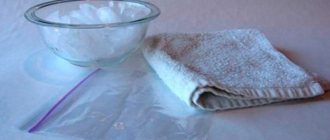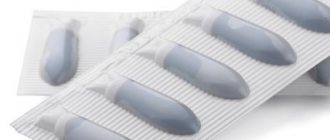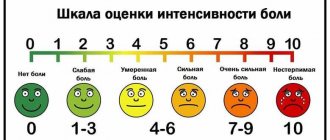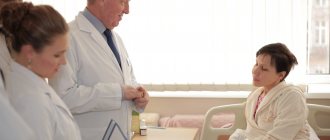All articles
Using suppositories for pain relief and treatment of hemorrhoids
26.09.2017
Suppositories for hemorrhoids are an effective treatment for the disease. The combination of various active ingredients allows you to eliminate the symptoms of the disease.
Today there are many effective ways to treat hemorrhoids. Symptoms can often be relieved with over-the-counter medications and lifestyle changes. One of the most popular remedies are suppositories, or rectal suppositories “for hemorrhoids”. Such candles have different effects and are used for specific purposes. Doctors do not recommend using several remedies to treat hemorrhoids at the same time. Also, you should not use medications containing glucocorticosteroids uncontrollably for longer than 5–7 days. Be sure to tell your doctor if your symptoms worsen while using them, such as increased itching.
Advantages and disadvantages of candles
Rectal suppositories are intended for insertion into the rectum. They contain an active substance and various auxiliary components. The candles soften and melt at the temperature of the human body, ensuring the supply of the active substance, and at room temperature they retain their shape.
Maintaining candles does not require outside help or special medical education, is a non-invasive treatment method, does not cause nausea and vomiting, and in most cases does not cause discomfort. Thanks to these advantages, rectal suppositories have gained popularity and are considered an effective remedy for hemorrhoids.
Like any other dosage form, suppositories also have disadvantages. Firstly, they require storage at low temperatures, often in a refrigerator. Secondly, using candles is not always convenient. Thirdly, some components of suppositories cannot be stored for a long time, so it is not recommended to buy suppositories for hemorrhoids for future use. Remember, candles cannot be used if they are cracked or damaged, or if their color or smell has changed.
Why does pain occur in the anus?
Most often, pain in the rectum is a symptom of the following diseases:
- hemorrhoids
- anal fissure
- thrombosis of hemorrhoids
- paraproctitis
- rectal tumors
Most often, pain is accompanied by bleeding during bowel movements. This is typical for hemorrhoids, as well as anal fissure. Pain from hemorrhoids is associated with the formation of enlarged hemorrhoids and a decrease in the outflow of venous blood from them. With an anal fissure, the integrity of the rectal mucosa is disrupted and tears form. With hemorrhoids, the pain is of medium intensity, and blood is often released in drops at the end of a bowel movement. An anal fissure is characterized by pain of high intensity - cutting, shooting, and bleeding can be significant. With an anal fissure, the groin and lower back may hurt, and urination may be reflexively impaired. Patients in such cases avoid bowel movements, which causes even greater constipation, which is a characteristic manifestation of both hemorrhoids and anal fissure.
Pain in the anus can occur when complications of hemorrhoids develop:
- paraproctitis
- inflammation of the subcutaneous fatty tissue of the rectum, - thrombosis
- the formation of blood clots in hemorrhoids.
When these complications occur, not only the nature of the pain in the anus changes - the constant feeling of itching and burning is replaced by intense, pulsating, shooting sensations. Other symptoms also appear: in the case of thrombosis, this is an increase in hemorrhoids and their acquisition of a “bluish” color; in paraproctitis
– increased body temperature, redness and swelling in the area of the external sphincter of the rectum.
Prolonged pain in the anus is characteristic of cancer. Tumor tissue grows sequentially through all layers of the rectum: this leads to constant irritation of nerve endings and pain of varying intensity. In this case, the pain syndrome is not associated with the act of defecation, and is constant, exhausting in nature, and is also difficult to treat with traditional methods.
Pain in the anus is a symptom that requires consultation with an appropriate specialist. This symptom is nonspecific and is characteristic of many diseases not only of the rectum, but also of nearby organs. Only a specialist will be able to conduct a full examination, recommend the necessary diagnostic measures, make the correct diagnosis and prescribe appropriate treatment.
Procto-Glivenol® is a modern, combined drug for the treatment of hemorrhoids
Procto-Glyvenol® reduces the incidence of bleeding from hemorrhoids thanks to tribenoside, does not contain hormones and antibiotics, is available in the form of suppositories or cream, which allows each patient to choose the most comfortable treatment.
More information about the drug
Effects of rectal suppositories
Anesthesia
Reduce pain due to analgesic components (novocaine, lidocaine, etc.). Anesthetic suppositories for hemorrhoids are prescribed for acute pain.
Reduce blood clot formation
Achieved through anticoagulants, which block blood clotting mechanisms. After taking such suppositories, blood stops clotting normally, so patients with a tendency to bleed are advised to first consult a doctor.
Anti-inflammatory effect
You can relieve inflammation with the help of non-steroidal anti-inflammatory drugs (aspirin, diclofenac), as well as hormonal drugs (drugs containing glucocorticosteroids). Natural substances (sea buckthorn oil, propolis) are also widely used.
Stop bleeding
In this case, drugs that are opposite in action to anticoagulants are used. That is, they activate the blood clotting process, stop bleeding, but can lead to the formation of blood clots if used uncontrolled.
Strengthening veins
Achieved by increasing their tone, strengthening the wall, and increasing elasticity.
In order to increase the effectiveness of suppositories for hemorrhoids and ensure ease of use, they sometimes include several active ingredients. For example, suppositories with analgesic, anti-inflammatory and hemostatic effects are popular.
We care about your health
Diseases of the large intestine do not always manifest themselves clearly and clearly. More often than not, the initial phase is accompanied by vague symptoms that people do not attach importance to. This may be a burning sensation, discomfort in the intestines, and periodic mucus discharge. The specificity of the intestines is that for a long time it may not give such signs that would indicate the need to visit a proctologist. Even when a person begins to be bothered by pain, bloating, discharge from the anus and other symptoms, he does not rush to see a doctor. At first, the patient persistently tries self-medication and those remedies that modern advertising intrusively offers. Meanwhile, the symptoms change, become more noticeable, painful and often aggressive.
Sometimes the symptoms may not indirectly indicate intestinal diseases; the symptoms may be specific:
- sudden weight loss;
- weakness in the body;
- disturbances in metabolic and hormonal processes;
- hair loss.
These signs accompany the most severe intestinal lesions: cancer, malignant tumors, polyposis. The intestine is the only organ that simultaneously belongs to two important systems of the body: the immune and gastrointestinal tract. For a full life and health, it is important to be able to recognize those symptoms and signs that indicate a pathological process in the large intestine:
- constipation;
- pain of varying intensity in the abdomen;
- bleeding during bowel movements;
- discharge of clear or purulent mucus;
- anemia;
- flatulence;
- intestinal obstruction;
- stool disorder;
- tenesmus;
- incontinence.
Intestinal constipation With constipation, difficulties with defecation are observed, up to the complete exclusion of stool for several days. Constipation can be constant and persistent and not respond to the effects of laxatives. An upset bowel movement can be replaced by constipation - this is a common picture with irritable bowel syndrome, dysbacteriosis, and functional disorders. The intensity of pain depends on the type of constipation: atonic and spastic. In the first case, the pain is aching, often not aggressive. With spastic constipation, there may be persistent pain in the groin area. The presence of frequent constipation indicates the possibility of fecal impaction or intestinal obstruction. The conditions are extremely dangerous in nature and can threaten life.
Abdominal pain Pain in the abdomen and groin often accompanies organic and functional disorders in the large intestine. Thus, with Crohn's disease and ulcerative colitis, the pain is in the nature of spastic contractions. Such pain often radiates to the lumbar region and radiates along the outside of the legs. It is difficult to determine the locality, since the pain “spreads” across the lower abdomen, often involving the perineum in the process.
Constant pain is a sign of a progressive inflammatory process. Such pains are aching, pulling, persistent. Manifested in IBS, various colitis, diverticulosis. The nature of the pain indicates the likelihood of developing peritonitis or a purulent lesion.
Bloody discharge and bleeding Bleeding occurs in diseases of the rectum and colon. Usually, the location of the lesion is visually determined by the color of the blood: the brighter the blood, the closer to the exit the lesion is. Thus, the appearance of clear and bright scarlet blood indicates internal or external hemorrhoids. Sometimes blood loss can be significant and cause weakness and dizziness.
If the stool is homogeneous and contains uniform bloody impurities, then this is a symptom of the formation of a tumor in the upper intestines. Sometimes such masses occur with nonspecific colitis and diverticulosis. The higher the lesion is, the more uniform the blood clots in the stool will look and the darker their color.
In Crohn's disease, blood may be released in pure form or in large clots. In some cases, scarlet blood may be a sign of a disintegrating tumor in the intestine.
Discharge of mucus or pus Such discharge is either constant or appears during bowel movements. Most often this becomes a sign of the formation of a fistula in the anus. With constant mucus secretion and pain, sphincter insufficiency can be assumed. In this case, numerous erosions and cracks form, which causes itching and pain.
Such discharge is characteristic of irritable bowel syndrome, proctitis, and the formation of tumors in the sigmoid colon. Often the discharge is combined with blood and the appearance of clots.
Pain in the anus Pain can be aching and periodic, bursting in the area of the passage. This happens with deep cracks; they heal with difficulty, especially if there is constipation. Jerking and unbearable pain occurs when hemorrhoids rupture or there are multiple nodes in the intestines. Regular hemorrhoids without complications do not cause such pain; they are only felt as distension and swelling in the anus.
Anemia Anemia develops when a person has lost a lot of blood. This occurs with severe intestinal lesions, cancerous formations, and rapid tumor progression.
Bloating and flatulence Bloating is a common sign for almost any pathology in the gastrointestinal tract. The feeling of bloating and heavy gases is typical with constipation, intestinal obstruction, and fecal impaction. Often flatulence is the result of enzyme deficiency and may indicate disturbances in the functioning of other internal organs. Bloating and flatulence often accompany those who suffer from dysbiosis and eat poorly. In some cases, bloating occurs with a feeling of discomfort and heaviness in the stomach, but with excess gas, severe abdominal pain may occur.
Intestinal obstruction Intestinal obstruction can be complete or partial. More often you have to deal with partial, which is characterized by:
- bloating;
- pain;
- flatulence;
- prolonged constipation;
- the appearance of impurities and blood;
- vomit;
- loss of appetite.
More often this indicates severe damage to the large intestine of organic origin. The condition is extremely painful and dangerous to human health. As it progresses, signs of poisoning of the body and inflammation of the peritoneum appear. With partial intestinal obstruction, stool is rare, scanty, and often replaced by profuse upset. Temporary improvement occurs under the influence of taking laxatives or cleansing enemas.
Stool disorder Diarrhea accompanies milder intestinal diseases, a common sign of dysbiosis. Also, stool disorder can be combined with other symptoms, such as constipation or various discharges. This happens with exacerbation of colitis, IBS.
Tenesmus Tenesmus is a false urge to have a bowel movement. With such urges, a small amount of mucus is released, sometimes along with diarrhea. Tenesmus is usually frequent, persistent, tiring a person with its frequency. Characteristic of excited motility of the rectum, they become a consequence of inflammation of the mucous membrane of the anus.
Incontinence Incontinence of fecal masses of secreted gases manifests itself with congenital or acquired changes in the sphincter. Another reason could be dysregulation due to psychological factors.
Features of application
When using suppositories, it is necessary to take into account their features and follow some rules:
- Carefully study the instructions for use and pay attention to storage conditions.
- Do not hold the candle in your hands for a long time, as it may begin to melt.
- If suppositories are used once a day, it is best to use them at night. If twice, then in the morning and in the evening.
- It is necessary to insert the suppository with clean hands while lying on your side, after bowel movements and performing hygiene procedures.
You can find out which suppositories for hemorrhoids are best for the patient, as well as how to take them correctly and for how long, after consultation with a specialist.
A comprehensive plan is drawn up individually for each patient, taking into account his age, gender, presence and absence of concomitant pathology and individual characteristics of the body.
Share:
Which candles are the most effective?
Here are the drugs with the best reviews for use in the first stage of hemorrhoids. We will tell you which suppositories for hemorrhoids are the most effective for women and men, their names, and also which suppositories are best for children.
- Methyluracil. This drug has a good anti-inflammatory effect. Almost all patients who used this drug noted remission. The drug accelerates healing and promotes tissue regeneration. Also, which is very important, these suppositories for hemorrhoids are inexpensive, costing less than a hundred rubles.
- Nigepan. These suppositories have an analgesic and anti-inflammatory effect, and also promote the lysis of blood clots. Their cost is slightly higher, but the drug is no less accessible.
- Proctosan. Candles have a natural composition. They have an analgesic, anti-inflammatory effect, reduce itching, eliminate bleeding from the veins of the hemorrhoid, and promote rapid healing.
Candles for severe pain syndrome
If painkillers are still ineffective, doctors advise using the following medications:
- Proctosedyl M. A drug with an analgesic, anti-inflammatory effect, has a hormonal component and antibacterial properties. Thanks to the active components in the composition, all symptoms characteristic of hemorrhoids are eliminated in the shortest possible time.
- Procto-glivenol. Eliminates pain and also relieves patients from itching. The drug helps improve blood flow in the hemorrhoidal node and eliminates swelling.
- Relief Advance. Suppositories for hemorrhoids with vegetable oils that eliminate pain and have an anti-inflammatory effect.
- Relief Ultra. In addition to pain-relieving components, it contains hormonal components, which makes it possible to more effectively combat the manifestations of hemorrhoids. The cost of this drug is higher, but justified.
- Hepatrombin G. The effect of the drug occurs very quickly. Within a minute it eliminates itching and pain in the anal area. It contains the hormonal drug Prednisolone. The drug is symptomatic, so its effect is not long-lasting.
inexpensive suppositories for hemorrhoids
Suppositories for hemorrhoids complicated by bleeding
Suppositories for hemorrhoids are inexpensive and effective in stopping bleeding. These include:
- Relief. One of the most effective drugs. In addition to having a hemostatic effect, it also has an anti-inflammatory effect.
- Anestezol. Stops bleeding and relieves pain. Its advantage is its low price.
Inexpensive suppositories against hemorrhoids
Often, suppositories for hemorrhoids are the most effective for men, the names above are expensive. Is it possible to find cheaper analogues? Yes! And we will definitely tell you about them further.
- Belladonna extract. This drug contains only herbal ingredients. It has a good anti-inflammatory and analgesic effect, but with more severe symptoms the drug is ineffective.
- Betiol. These suppositories have an antispasmodic and analgesic effect. They can also be purchased at an affordable cost.
- Ichthyol. A drug with an analgesic and antiseptic effect. Cheap and effective.
Attention! Suppositories for hemorrhoids for children, pregnant and lactating women, people prone to allergies, and nervous disorders are used strictly as prescribed by a doctor and under his direct supervision.
Suppositories for hemorrhoids for pregnant women and lactation
Most suppositories for hemorrhoids are contraindicated for pregnant women and during breastfeeding. After preliminary consultation with a doctor, Posterisan, Betinol, Olestezin and Neo-Anuzol can be used in the first trimester of pregnancy. In the second trimester of pregnancy, with extreme caution, doctors prescribe Relief Advance and Gepatrombin G.
Candles for treating children
Pediatricians in children recommend using only inexpensive suppositories for hemorrhoids with natural oil ingredients, especially sea buckthorn oil. They have an anti-inflammatory effect and promote healing and tissue renewal. Such candles have one drawback - an orange color, which stains underwear and bedding. It is not easy to wash, almost impossible.
Suppositories after surgical removal of hemorrhoids
At more advanced stages, surgical treatment is prescribed - hemorrhoidectomy, which consists of surgically removing the hemorrhoid followed by suturing. Treatment after surgery should be multicomponent. First of all, after surgery it is necessary to eliminate pain, inflammation, prevent postoperative bleeding and other complications.
One of the most recommended drugs in the postoperative period is suppositories for prolapsed nodes Methyluracil. The drug has minimal side effects, is very safe and effective. Promotes a speedy recovery and rapid tissue regeneration due to the fact that it has the following properties: anti-inflammatory, anabolic, regenerative and leukopoietic, and there is also an immunomodulator effect to some extent.
Also, after surgical treatment, doctors prescribe the most effective suppositories for hemorrhoids for women and men: Ultraproct, Posterisan Forte, Natalsid, Relief, Gepatrombin G.
From a series of drugs with natural ingredients, Sea Buckthorn Suppositories and Propolis have analgesic and anti-inflammatory properties.







